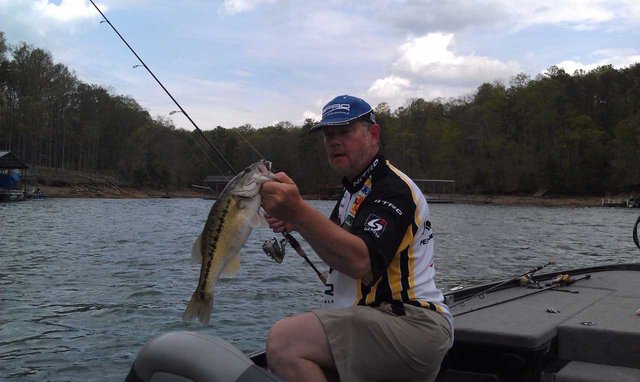Lake Lanier’s water level has held fairly level and water quality is improving.
The current level 1,070.33 or .67 foot below the normal level 1,071.
Lake Lanier’s surface temperatures have ranged from 53-56 degrees.
The lake turnover period is almost complete.
The main lake and creeks have cleared, but there is some stained water in the back of the creeks. Water up lake ranges from clear to stained, but the water will get muddy in a hurry from the Chattahoochee, when winter rains occur.
The Chattahoochee River below Buford Dam is still stained but has continued to improve.
Trout fishing improves when the water clears in winter.
Check generation schedules before heading out to the river at 770-945-1466.
Bass: Fishing has been feast or famine this week.
The better fishing seems to be in deeper water.
This is the time for you to trust and react based on what your electronics show. Too many anglers I know don’t put together what they see with how they fish. If shallow is your deal, don’t give up. We caught fish from as shallow as 10 feet on out to 35-60 feet deep.
The fish have really stacked up in the creeks, pockets and ditches.
First thing, at day break, the fish will come up shallow in the pockets and ditches. The best lures seem to be an underspin-jig head with small minnow trailer fished very slow down the dropoffs and in the middle of ditches. The second has been a SPRO McRip 85, worked slow and steady with an occasional stop-and-pull retrieve.
The majority of bass have either moved or have stayed there feeding on shad and bluebacks at 30-60 feet deep.
The shad will usually be stacked up in schools from 25-45 feet and the predator fish will be either schooling in just under the baitfish schools or they will be resting right on the bottom where they are hard to see on your graph.
The secret, for me, to learn how to target deeper fish and how to catch them on artificial was to spend a lot of time with a single technique where I could see my lure as well as the fish on my electronics.
Back then, it was a flasher first then a Lowrance X-75 and a jigging spoon.
Every 100 drops, I would catch a fish I saw, which was cool. Sometimes they bit every drop or every 10 drops but catching fish we could see out deep was so cool, so we learned how to do it.
Now it is even easier with GPS and all the other advances in sonar and it doesn’t slow down.
There have been bass out over deep flats, as well as directly in the middle of the pockets.
Find the huge bait schools and the fish will be close. One of our best lures is a 1/2-ounce Flex-It or Hopkins jigging spoon.
I replace the stock hooks with a No. 4 or 5 Gamakatsu Nickle Treble hook and add a SPRO Swivel with split ring.
Fish these lures on heavy 17-20-pound Sunline Mono or Fluorocarbon.
Pop the jigging spoon around suspended fish or just off the bottom.
The thicker line slows the fall and allows you to pull the hooks straight when you get snags.
Other techniques are also working well out deep.
A drop-shot rig with a Lake Lanier Baits Fruity Worm is a great lure. You can see this rig drop clearly on any modern-day fish finder.
Try the natural and blue-color Fruity Worms.
I used a small LLB Runt in Chartreuse this week just because it matched the bait fish we were seeing, plus I had a bunch.
A regular 4 or 6-inch inch worm will also work well.
If you are fishing a bluff wall, try casting your drop rig or the 6-inch on a Shaky Head.
Let it fall and work it on the bottom down the fast drop.
You may have to open your bail to let line out, but this can be a productive method for catching fish.
There are some bigger bass eating crawfish around rocky banks both on sunny afternoons or even after dark.
Stair step a jig or Cast a SPRO RkCrawler and fish them through the rocks from shallow to deep.
Striper fishing rates from fair to very good.
The water has cleared and the gulls and loons will show you good locations to fish.
Use your electronics and fish where you mark bait and fish and see bird-feeding activity.
The stripers have been in the creeks and large coves, targeting shad and herring in 25-45 feet deep.
Anglers have been catching fish on mostly live herring, trout, gizzards and medium-sized shad.
If you are new to striper fishing, consider investing in an experienced guide for a start.
Ask questions, watch what they do, where they go and how they fish.
When you mark fish on your electronics, set out a few downlines at just the upper level where you see fish.
Move the boat around slowly or let it winddrift or sit still for a little bit when the wind slows down.
If you have the anchor feature on your trolling motor, it will come in very handy when you get over fish out in the wind.
Also try putting out a bigger bait like a trout and feed it out way behind the boat on a flat line.
We used to feed a big trout way out about 20-feet, tie a balloon on the line and feed it out far enough to leave enough line to fight a big fish when we got hit.
Trolling smaller umbrella rigs like Captain Mac’s Mini Rig have been producing some bites both in the creeks and out around pockets and secondary points.
Troll these out on 7-8 colors lead core or set them on a down rigger around 15-20 feet deep.
Run your boat at 2 mph.
You can also cast the same Mini Rigs where you mark fish.
Let them sink down to where the fish are and reel them up through the school.
Jigging spoons can also trigger a bite from stripers too.
One greatly overlooked technique is to cast a 3/4-ounce SPRO Bucktail around these mid-to-deeper fish.
Fishing around the green lights after dark with McSticks is still good, but this seems to be a one or two and done and on to the next light technique.
I have heard, and even seen, boats catching fish after fish from lights with finesse techniques.
Try using pitching a live bait or cast small jigs or even small streamers on a fly rod.
Stay as far as possible away from the lights and make casts to where the light stops and the shadow begin.
Crappie: The Crappie are out hanging with all the other fish, eating shad from 20-35 feet deep.
We have caught them during the day using jigging spoons while targeting bass.
Once you get around a school of crappie, they will hit small jigs fished deep.
Use light line from 2-6-pound test and use a small 1/16-1/32 ounce head with a small fluke style trailer.
Work these jigs around deeper docks with brush and even open water where the shad are schooled in deeper water.
Bank Fishing: The Chattahoochee River below Buford Dam is starting to clear up from lake turnover.
While it is not exactly clear yet, this can be a good time to catch holdout trout that survived after being stocked earlier this past or previous years.
These trout will usually be bigger and fight harder.
Remember that live bait is not permitted below the Highway 20 bridge.
If you want to fish live bait, try a live red wiggler on a weighted line in the pools below the rapids.
These deeper trout are used to seeing worms after all the rain we have had.
My go-to lure in winter that I can use anywhere on the river is a small Rapala Countdown.
Cast this small-minnow imitator up stream and work it with a hard jerk-and-stop retrieve.
Wounded and dead shad get washed through the Dam so this can be an awesome way to fool a bigger trout.
Fly fishing is good with wet flies.
Flies that mimic pre-emergent bugs like hellgrammites, mayfly and other bottom feeders are working well.
Look for some afternoon knat hatches that have caused some fish to rise.
Eric Aldrich is an outdoor writer, marketing specialist and bass angler. Reports are based on personal experience and permission from a close network of friends. He would love to hear from his readers so please email him at esaldrich@yahoo.com Remember to take a kid fishing!
Credit: Source link































